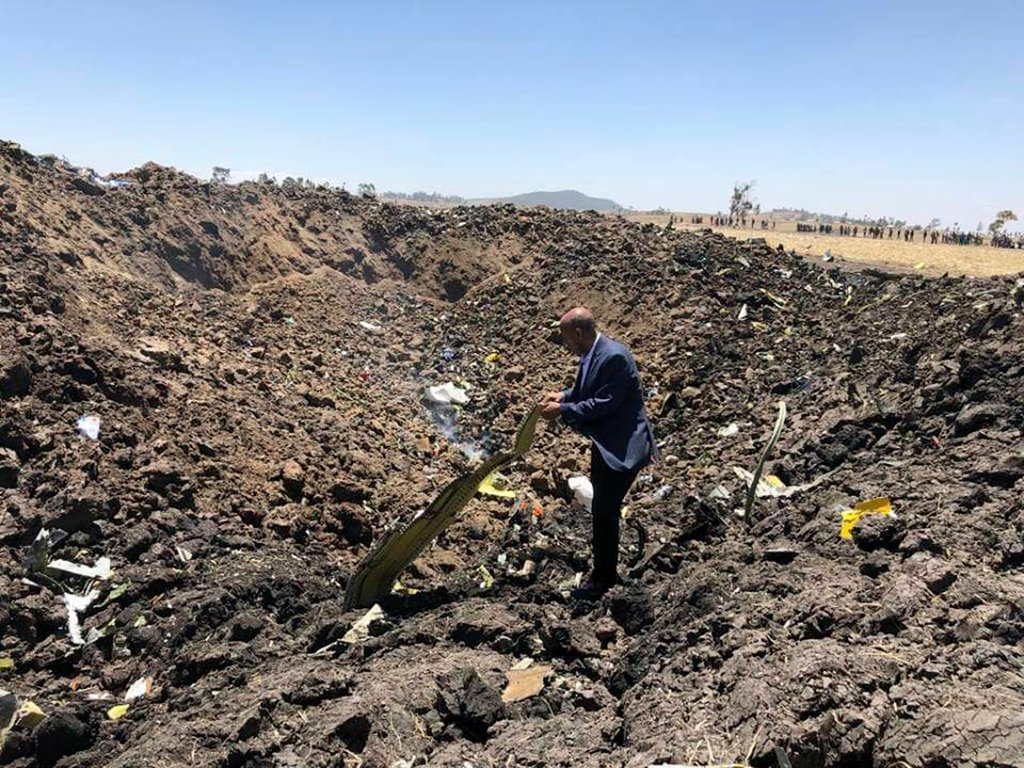An Ethiopian Airlines flight carrying at least 150 people crashed early Sunday shortly after departing from the Ethiopian capital, Addis Ababa, en route to Nairobi, Kenya, the airline said, killing everyone onboard.
The plane was identified by its manufacturer, Boeing, as one of its newest models, a 737 Max 8. The cause of the crash was unclear, but a Lion Air flight using the same model of plane went down in Indonesia in October and killed 189 people.
Officials are investigating whether changes to the Max 8’s automatic controls might have sent that flight into an unrecoverable nose-dive.
The airline said Flight 302 was carrying passengers from at least 35 countries. The dead included 32 Kenyans, 18 Canadians, nine Ethiopians, eight each from the United States, China and Italy, and seven each from France and Britain, the airline said.
The flight on Sunday took off from Bole International Airport in Addis Ababa at 8:38 a.m. local time and lost contact six minutes later, the airline said. The plane went down near Bishoftu, about 35 miles southeast of Addis Ababa.
The flight took off in good weather, but the vertical speed of Flight 302 was unstable, according to data published by FlightRadar24 on Twitter.
Tewolde GebreMariam, the chief executive officer of Ethiopian Airlines, said at a news conference that the pilot had sought and had been given clearance to return to the airport in Addis Ababa after reporting difficulties.
Mr. GebreMariam said that it was too early to determine a cause or rule anything out, adding that a team from the National Transportation Safety Board in the United States would be arriving shortly to work with civil aviation authorities in Ethiopia and officials from Boeing. The N.T.S.B. confirmed that it would be sending a four-person team.
Relatives were left with an anxious wait for news, as journalists from around the world descended on Jomo Kenyatta International Airport in Nairobi. At least three buses carrying family members left the airport for a nearby hotel, and emergency responders were shielding them from the press.
“I came to the airport to receive my brother but I have been told there is a problem,” said Agnes Muilu, The Associated Press reported. “I just pray that he is safe or he was not on it.”
The office of Abiy Ahmed, the Ethiopian prime minister, expressed condolences on Twitter, as did President Uhuru Kenyatta of Kenya.
The Kenyan transport secretary, James Macharia, said his country was setting up two emergency response centers to assist those who had friends and relatives on the flight.
“The purpose of these centers is to provide the relatives with information as much as we have,” he said. “At the same time to provide them with an environment of privacy.”
There has not been a crash involving Ethiopian Airlines since January 2010, when a Boeing 737 crashed into the Mediterranean Sea shortly after it took off from Beirut, Lebanon. None of the 90 people onboard that flight — 82 passengers and eight crew members — survived.
The latest known accident involving the airline was in January 2015, when a Boeing 737-400 cargo aircraft veered off the runway with flat tires after it landed in Accra, Ghana. None of the three crew members onboard were injured.
The Lion Air Max 8 in Indonesia was a brand-new plane, like Ethiopian Airlines Flight 302, which was delivered to the African carrier late last year, according to websites that track commercial fleet updates.
Crashes involving new planes in good weather are rare. The Lion Air accident also involved a plane that crashed minutes after takeoff and after the crew requested permission to return to the airport.
Investigations by the Indonesian and American aviation authorities have determined that the Lion Air plane’s abrupt nose-dive may have been caused by updated Boeing software that is meant to prevent a stall but that can send the plane into a fatal descent if the altitude and angle information being fed into the computer system is incorrect.
The change in the flight control system, which can override manual motions in the Max model, was not explained to pilots, according to some pilots’ unions. Global alerts were sent to notify pilots flying the Max about how to counter the anti-stall system.
Ethiopia, with about 100 million people, is the second-most populous nation in Africa. After elections in March, the new prime minister has embarked on a series of political reforms, chiefly to officially end two decades of hostilities with neighboring Eritrea, a longtime rival.
The country’s flagship carrier has undergone a major expansion in past years, more than doubling its staff to 11,000 employees in the past decade, with the goal of easing air travel in a part of the world where flying is notoriously complicated. For instance, it added nonstop flights from Newark to Lomé, Togo, a hub for the airline, that then continued on to Addis Ababa.
In West Africa, Ethiopian is the technical and strategic partner for a relatively new airline, Asky, created with investment from the Economic Community of West African States. Asky offers a web of cross-border flights in West and Central Africa and connects with Ethiopian flights to expand its reach across the continent and beyond.
In Africa, Ethiopian has a reputation for having a newer fleet than other airlines, for operating flights that are mostly on time and for having accommodating schedules.
The airline has ordered 30 Boeing 737 Max jets, with the first being delivered last year. It currently has five of the models in its fleet, according to FlightRadar24.














